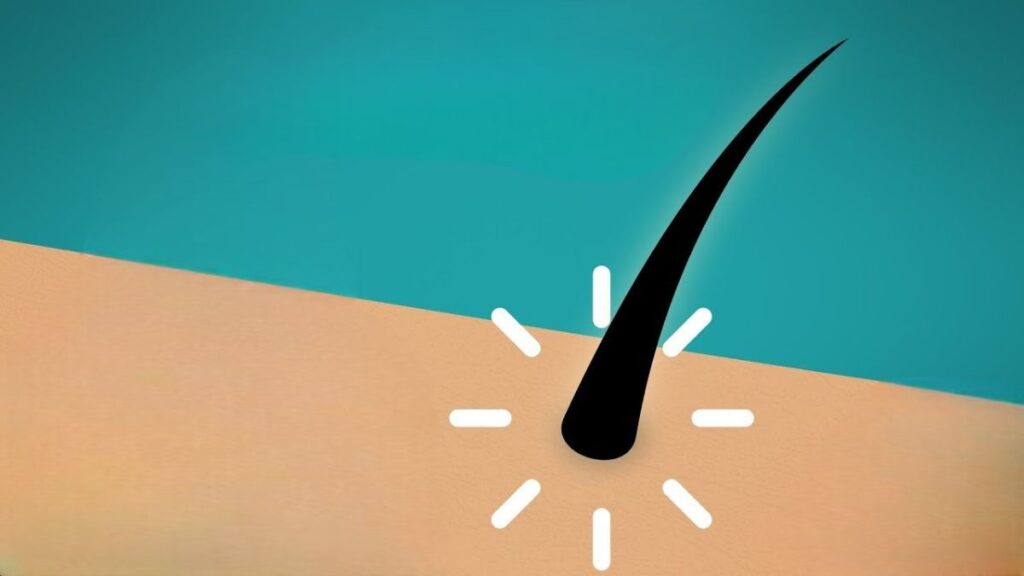
We’ve all been there: you’re going about your day, looking in the mirror, and all of a sudden you see dark, thick hair growing where it didn’t before.
To be clear, there has always been hair growing there; it simply didn’t seem to be that previously.
Even though scientists are aware of the reason why some hairs change from peach fuzz to something a little more luscious, this does not make the transformation any less random.
Although some parts of your body, like your head and armpits, really draw attention to their hairy adornments, almost every part of your body has hair.
Truth be told, you have similar number of hairs stuffed into each square centimeter of skin as a chimp – it simply doesn’t seem as though it since you’ve by and large got two unmistakable sorts of hair.
People in the business refer to the light, thin peach fuzz on your arms and back as vellus hair, while terminal hair is the long, dark, and attractive hair that is more commonly associated with the top of your head and your unmentionables.
However, this does not imply that everyone’s back resembles a baby’s butt; The degree to which the hair on various parts of our bodies can become dark varies among humans.
Therefore, think of those instances as areas that are lighter and darker than your other body hair.
Additionally, we value and adore both kinds of hair for their distinct roles in our survival.
To begin, you need to shield the top of your head from the sun’s ultraviolet rays, which are directed toward Earth.
Furthermore, terminal hairs that are thicker and darker are more likely to absorb more UV rays, preventing them from reaching the skin below.
However, we are protected from overheating by vellus hairs, which prevent us from being exposed to the sun.
At the point when people overheat, we sweat, and people are especially damp with sweat creatures.
Compared to other primates, we have significantly more sweat glands.
However, if we had the same number of terminal hairs, they would cover those glands, making it impossible for the sweat they produce to escape our bodies and cool us down.
Therefore, having those sparse vellus hairs is extremely beneficial in some areas of your body.
However, in other parts of your body that get a lot of sweat, like your armpits and buttocks, you have a lot of terminal hairs stuck where the sun doesn’t shine, so they don’t really seem to be ready to block a lot of UV rays.
Therefore, some research suggests that they might assist you in spreading your musk and attracting a partner.
That could help explain why these terminal hairs typically appear during puberty.
However, it is evident that puberty is the time when a lot of dark hairs begin to appear, regardless of the reason why armpit hairs grow so large.
Additionally, despite the fact that they appear out of nowhere, it turns out that they have always been there.
Those suddenly dark hairs were once vellus hairs. Your hormones, particularly your androgens, pushed them into the transformation of a lifetime.
A gene known as hha7 can be activated when androgens bind to a vellus hair follicle.
Additionally, when that gene is activated, the vellus hair follicle begins to utilize a greater quantity of the protein keratin, resulting in longer, thicker, and darker hair.
This hha7 gene is not present in every vellus hair cell in your body, but it is present in some surprising places, like your scalp.
Therefore, they are not restricted to the locales renowned for their excessive hair growth following puberty.
In addition, there are more receptors on some of these hha7-positive cells, making it easier for androgens to initiate the switch.
Therefore, some cells are predisposed to a darker, thicker fate regardless of where they are located on your body.
The body makes different amounts of androgens as people go through life stages like puberty, pregnancy, and menopause. Any one of these changes could cause whole patches of vellus hairs to turn into terminal ones.
However, what about those single terminal hairs that appear on a whim?
The hha7 gene may also be activated by an enzyme known as five Alpha reductase if it isn’t an errant androgen molecule.
Dihydrotestosterone, or DHT, is the product of this enzyme’s conversion of the well-known androgen testosterone.
Additionally, a process that culminates in the hair expressing genes that are not hha7 and transforming it into a terminal is initiated when DHT interacts with a vellus hair follicle.
In point of fact, studies have demonstrated that some individuals who have more terminal hairs do not have elevated levels of androgen.
They simply have five Alpha reductase enzymes that are more active. The exact cause of this increased activity is unknown, but it could be genetic.
So, the science behind the transition from vellus to terminal hair can get a little hairy, but it’s not as unfathomable as it seems right now.

![Moon Jellyfish has [ Hidden Secrets ] You don't know moon jellyfish](https://spaceupper.com/wp-content/uploads/2022/11/1-1-300x169.jpg)









